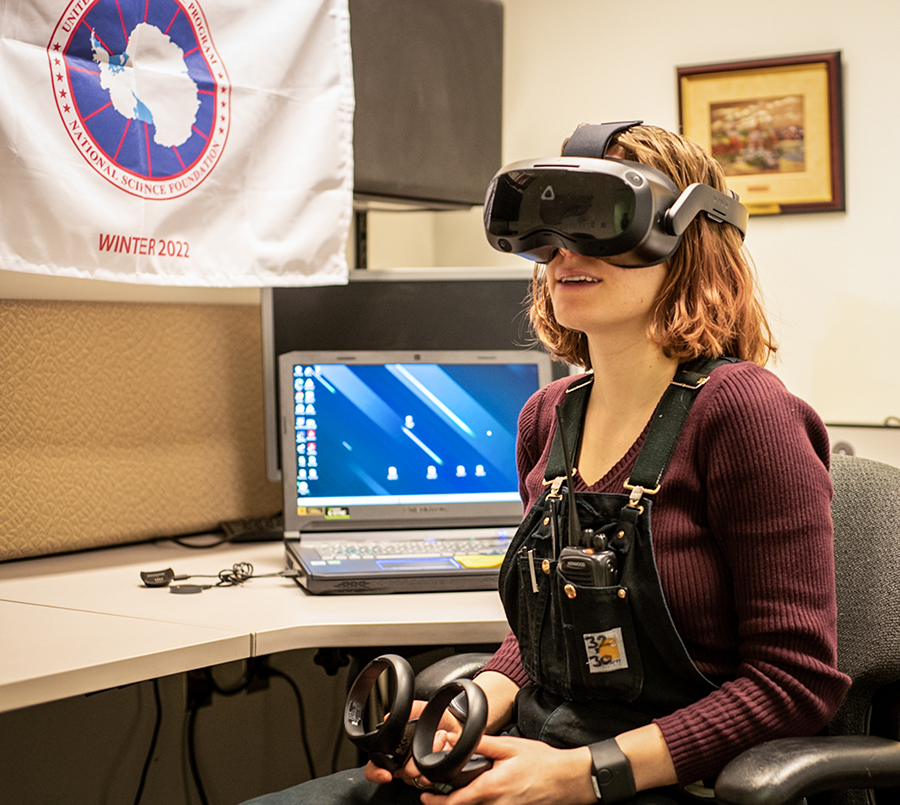
Photo by John-Michael Watson |
A South Pole station winterover resident participates in an experiment to test the effectiveness of virtual reality as a therapy for living in extreme, isolated environments. |
South Pole winter crew participate in virtual reality study
Station staff tested a therapy that could be used on future space missions
By Lauren Lipuma, Antarctic Sun Editor
Posted January 09, 2023
The 2022 winter crew at Amundsen-Scott South Pole Station took part in a unique experiment to test the effectiveness of virtual reality as a therapy for living in extreme, isolated environments.
Working with researchers at NASA, Massachusetts General Hospital, and Harvard Medical School, South Pole station staff participated in a series of immersive virtual reality sessions that simulated various urban and natural environments. More than 20 residents - about half the station population - participated in the sessions during September and October 2022.
The results will help researchers understand if virtual reality could alleviate some of the stress of living in isolated, confined, and extreme environments on Earth and in space. NASA researchers hope the findings of this and similar studies will tell them if virtual reality could improve astronauts' mental health on long-duration spaceflight missions or during deployment on remote space stations.
“It's exciting to think about whether someday we will see this sort of thing on a moon base or being used in space,” said John-Michael Watson, the 2022 South Pole winter physician who guided the sessions and collected data for the study. “I think the participants really took that to heart, knowing that their opinions certainly one day may have influenced hardware that they'll see up in space.”
Living in a remote environment
Amundsen-Scott South Pole Station is one of the most remote research stations on Earth. Residents who winter there spend six months in darkness, confined to the station and its surrounding buildings, with only each other for company. They see no plants or animals during their entire stay and have internet access for only about eight hours a day. The stress of no sunlight and lack of communication with the outside world can often be detrimental to winterovers' mental health.

Photo Credit: John-Michael Watson.
A South Pole station winterover resident participates in the virtual reality study. The headsets projected images of city and nature scenes that participants could explore virtually. The experiment engaged other senses as well, incorporating sounds and even warm and cool temperatures into the experience.
During the 2022 austral winter, the U.S. Antarctic Program partnered with NASA and Harvard University to test whether virtual reality simulations could help alleviate some of that stress. Because of its remoteness, South Pole station is a good analog for space bases and the conditions astronauts face during spaceflight. Residents who winter at the station go through a rigorous physical qualifying process that is similar to the process used to choose astronaut candidates.
“The population that's already there has already sort of been selected out also as those kinds of folks that might be on the moon eventually,” Watson said.
Station residents who participated in the study were given virtual reality headsets to wear for four or 10 minutes at a time. The headsets projected images of city and nature scenes that participants could explore virtually. The experiment engaged other senses as well, incorporating sounds and even warm and cool temperatures into the experience.
“There was a temperature device that would get either hot or cold and based on whether the scenario was in New York with a blustery cold breeze with clouds… or a warm sunny day in Portugal,” Watson said.
The researchers collected biometric data like heartrate and temperature from each participant as well as personal feedback on their experience.
“Some of our crew members had been on station for over a year when they started to view these scenarios, so they had not seen trees or animals or other people,” Watson said. “So some of those especially very initial sessions were sometimes very emotionally charged… there were several people who mentioned specifically, ‘Oh, I didn't remember how birds sounded and how loud they were.'”
The sessions took place during September and October 2022, at the tail end of the austral winter. Now that the data has been collected, Watson and the other researchers hope to publish their results sometime next year. Station staff may even repeat the experiment next winter.
“Those initial responses were a lot more profound than I would have guessed,” Watson said. “When you've been on the ice for over a year, I think a lot of those things have just become memories and so all of a sudden to see those sights and sounds is pretty wild.”






